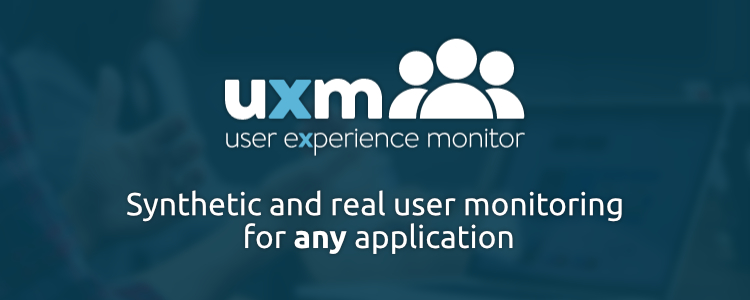User Experience Monitoring (UXM) combines the benefits of Synthetic Transaction Monitoring (STM) and Real User Monitoring (RUM)

In Application Performance Management (APM), there are two main technologies used to measure end-user perspective performance: synthetic transaction monitoring (STM) and real user monitoring (RUM).
While many solutions only provide either STM or RUM, there is a new option, UXM (User eXperience Monitor) , which combines the best aspects of both approaches with innovative thinking to offer a uniquely powerful platform—one that can cope with virtually any application, user device and underlying technology (old or new).
So whether you’re monitoring packaged applications and services such as SAP, Office 365, Salesforce, G Suite, Microsoft Teams, or your own bespoke application, UXM has you covered!
What is synthetic monitoring?
Synthetic monitoring, also called synthetic transaction monitoring (STM) or active monitoring, uses pre-recorded scripts to mimic user actions within an application. Synthetic monitoring enables you to measure the availability and performance of applications as well as the supporting infrastructure. Synthetic transactions can run 24 hours a day and will let you know immediately if any problems arise.
You can think of synthetic transactions as a robot that’s constantly monitoring an application by completing key user journeys.
Benefits of synthetic transaction monitoring
The benefits of STM include:
- When using STM, you’ll be notified of an application outage first, usually before a real user. This means you can respond faster and notify your operations and support staff before any damage is done.
- Synthetic monitoring allows you to continually monitor the performance and reliability of an application 24 hours a day, even when no users or customers are accessing the application, ensuring that when they do need the application, it’s up and available.
- Third-party applications or SaaS apps like Office 365 are increasingly becoming the majority of the applications IT delivers. Synthetic monitoring for these apps is often the only available insight as third-party applications often can’t be instrumented or altered by customers.
- Since synthetic tests run repeatedly at regular intervals, this builds up an extremely valuable baseline history for availability and performance, which is perfect for seeing trends over the long-term and assessing compliance against SLAs.
Limitations of synthetic transaction monitoring
The primary limitation of synthetic monitoring is that it doesn’t tell you what your actual users are experiencing. This might mean that you believe the application is performing well, but you have some users affected by poor networking or some other problem.
Other limitations include:
- Can miss problems with specific browsers.
- Can miss problems with parts of the application or API that are not being tested.
- Geographical problems where you don’t have coverage for a network or application.
- Can’t see problems with a specific user’s desktop or laptop.
- Intermittent problems with a network or application stack that may be difficult to reproduce with synthetic monitoring.
What is real user monitoring?
Real user monitoring (RUM) is a method of monitoring how actual end-users interact with an application. Ideally, RUM works hand-in-glove with STM and, together, provides the full picture of user experience.
RUM is also known as a real-user measurement, passive monitoring, real-user metrics, or end-user experience monitoring (EUEM).
In contrast to synthetic monitoring, real user monitoring captures everything that a user does within an application in real time.
There are various ways to capture real user activity for an application, depending on what kind of access you have to the application or API:
- If you have access to the servers and application stack: Javascript injection can capture the performance of a web page, but this is often difficult to accomplish when the issue may exist across different servers or third-party web/micro services.
- Through web browser extensions
Benefits of real user monitoring
The benefits of RUM include:
- With RUM, you capture the experience of a user, no matter where they are. If you have a user that is roaming or telecommuting and they are experiencing poor performance, you may not have synthetic transaction monitoring in place to detect the issue.
- RUM will give you the real picture of user experience since it focuses on real activity and not just the things for which you have set up STM.
- RUM can be ideal for monitoring and focusing on critical line-of-business apps (LOB), like Salesforce, that may be mission-critical for some users.
Limitations of real user monitoring
Limitations of RUM include:
- Real user monitoring (RUM) can’t tell you anything about your systems or, more importantly, third-party cloud and SaaS Apps, when you don’t have a user using them. This may not be as critical for systems you own, because you probably have infrastructure monitoring in place that’s telling you if you have a problem with servers. But for systems that you don’t own—like Office 365 or Salesforce—you want to know ahead of time whether those systems are having problems.
- For you to know about an issue with RUM, one of your users has to experience the problem. It’s better to find out about errors with synthetic transaction monitoring, affecting a robot user, rather than an outage or problem affecting a real user.
Combining synthetic transaction monitoring with real user monitoring
Combining synthetic and real user monitoring gives a complete view of the user experience along with insight into the application, the supporting server and network infrastructure.
On its own, STM can miss problems experienced by various user populations in areas where you may not have STM coverage.
On its own, RUM can miss outages, page errors and third-party problems that would be picked up by STM.
Introducing UXM (User eXperience Monitor)
UXM is a complete solution which combines both STM and RUM. Its RUM capabilities are extremely granular, capturing second-by-second detail of your users’ experience over time and its STM capabilities cover a broad range of technologies.
Using UXM, you combine the benefits of both technologies to gain a holistic view of the system, infrastructure and user experience. Employing both techniques in tandem eliminates the blind spots of each and can provide a business with the best view of their users’ experience.
With UXM, you get monitoring that covers virtually any application. For example, this could be:
- A cloud hosted third-party application like Office 365, GSuite, ServiceNow or Salesforce.
- An on-premises hosted third-party application like Exchange, SAP or Dynamics CRM.
- A Windows desktop application
- An application accessed through virtual desktop (VDI) or Citrix.
- A VOIP service such as MS Teams or Skype for Business.
- A home grown business critical application hosted on-premises or in the Cloud.
- An API endpoint
UXM allows you to continually test not just applications, but single sign-on, uploads, downloads, network path performance and much more. In the case of Skype for Business or Microsoft Teams, UXM tracks the performance and quality of your voice and video streams.
UXM is provided as a managed service in many cases, so you don’t have to maintain scripts or keep up with application modifications - the UXM team takes care of that for you.
In summary
RUM and STM are both valuable tools for measuring user experience and having this visibility is more important than ever with the rise in numbers of people working from home (see what happens when home network conditions aren’t up to the job).
By using UXM which combines both approaches you can unlock benefits such as:
- Eliminating finger pointing
- Reducing Mean-Time-To-Resolution (MTTR)
- Understanding impact on actual users allows for better business decisions
- Bringing business owners into the discussion
A unified system combining both synthetic and real monitoring facilitates organisational changes, and, if implemented well, provides much greater ease of use, a single system to learn and data combined and displayed in a common manner.
UXM unlocks all of these benefits and when used as a managed service, you can rely on the team to help define, deploy, maintain and even interpret your complete application monitoring solution.
This leaves you to focus on other tasks that add value to your business.
If you want to try out UXM for yourself, start a free trial now. Or if you’d like to talk to us first and see a demo, we’d love to hear from you.

